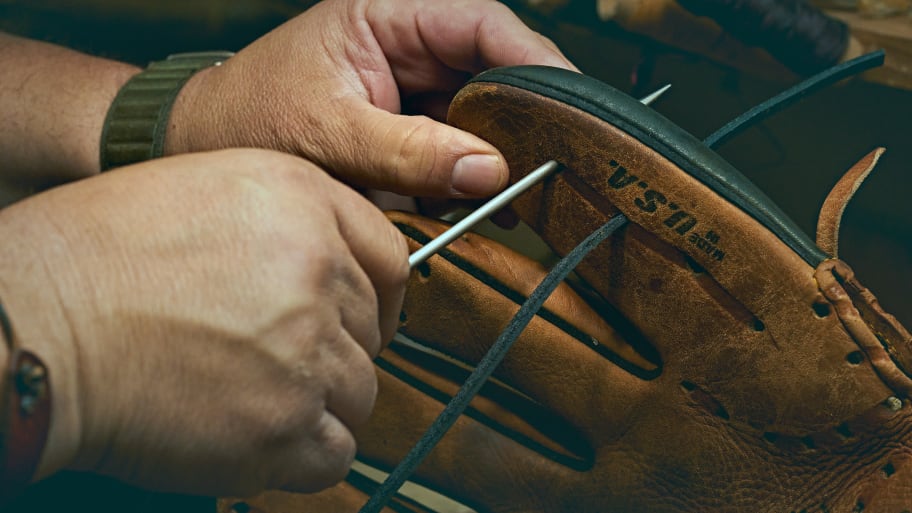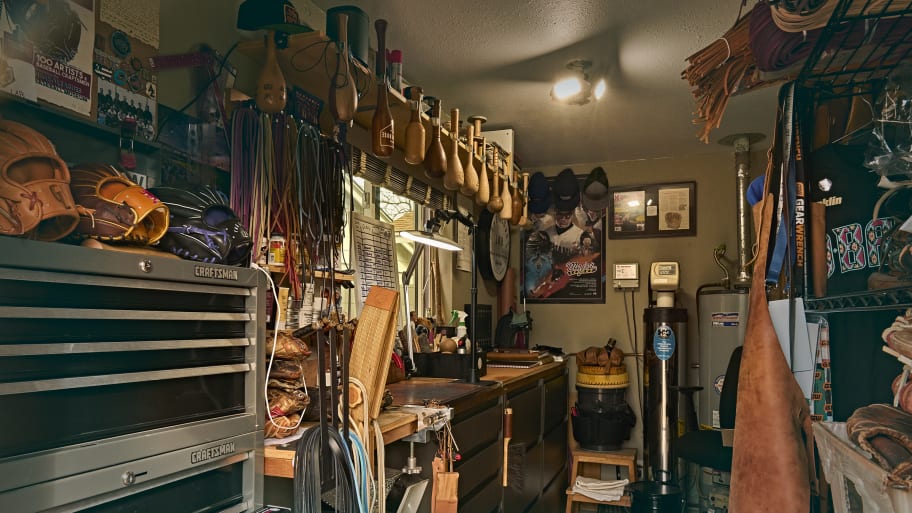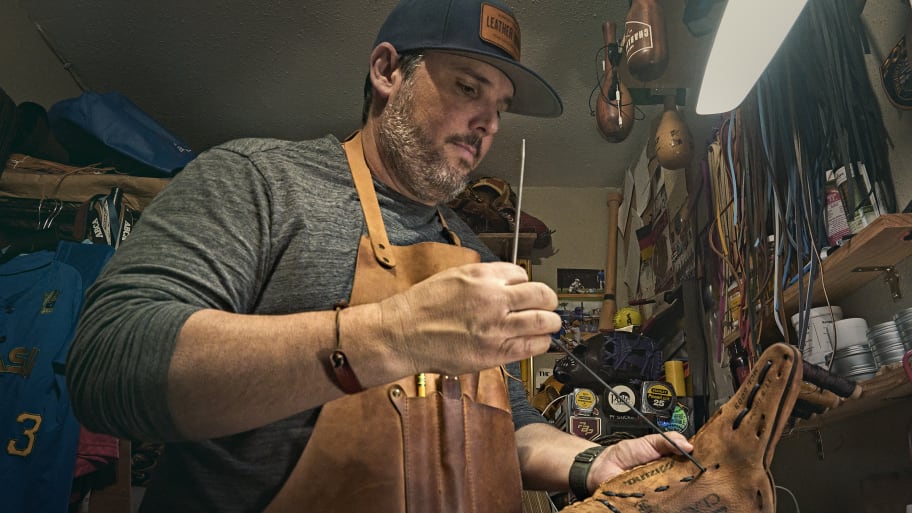The gloves come with history. They show up at Chris Petroff’s home in suburban Phoenix, a few deliveries per day, UPS, FedEx and regular mail. He will learn the biography of each one.
Petroff can figure out whether a glove was broken in properly. He knows if a player is catching the ball in the pocket consistently or if he struggles with it popping out. If a pitcher has been using any sticky, grip-improving substances, Petroff can tell. A glove that was forgotten in the rain will be obvious, and one that was left in a truck bed to swelter under direct sun will be, too.
Sometimes, the histories are more literal. A letter will be tucked inside the package, handwritten or neatly typed. The most common glove stories are those of family—parents and kids, games of catch, an old favorite needing to be fixed up so it can be passed down. But there are other themes. Some gloves are tied up in friendship. Some come from tragedy, one recovered from the wreckage of a bus crash, another found in the ashes of a house fire. Petroff didn’t need to read the note for that one: He could smell it.
Players from MLB down to Little League send their gloves to Petroff, and, inside his backyard work shed, he re-laces, restores and repairs them. The 43-year-old is officially a professional baseball glove technician. But he is more like a caretaker for the most precious of sports equipment. Not every player is particular about their glove. But for those who are? The relationship is personal. Some big leaguers use the same glove not just for multiple seasons but for an entire career. They will give it a name and prevent teammates from borrowing it. (That’s another kind of letter Petroff occasionally gets: Here’s my glove, thanks in advance, but please, please don’t put your hand inside.) There are players who do not dare pack their glove in an equipment bag on road trips, holding it tight instead as a priceless carry-on. The glove can be more than an extension of the body. It’s an extension of the self. And for every pro who feels this way, there is a beer league player, or a teenager, or someone who hasn’t played since high school but cannot part with their leather all the same.
They all care deeply about their gloves. So they send them to Petroff, who in just a few years has become the go-to practitioner for many in MLB. He does hundreds of repair jobs each year, gloves and mitts, baseball and softball, minor fixes and full-on rehabilitations. They arrive on his doorstep from all over and range from relatively new to decades old. Every one is part of a love story.
In 2018, Petroff was coaching a youth team for his 10-year-old son, Jack. A lace broke in his glove. This was an easy fix, Petroff assured him: They could stop by the sporting goods store and make the repair themselves. It would take only a few minutes. It would also let Petroff show Jack something that his own father had shown him.
When Petroff made varsity at first base as a high school freshman, his dad bought him a gorgeous mitt for the position: a Wilson A2000 A2800. Petroff was in love. And he was horrified when a lace broke a few weeks later. But when he worked up the nerve to tell his parents, he learned that it would be a simple fix. His father, David, worked as an architect and had always been handy. Every family on their street knew to come to him when something was broken. On his way home from work the next day, David picked up a new lace, and that night, father and son fixed the glove together in the garage.
“He showed me that things can be repaired, not replaced,” Petroff says. “That’s always stuck with me.”

So Petroff showed his own son how to cut out the busted lace and weave in the new one, pulling it tight but not too tight, “three-bears-just-right,” as he puts it. This was fun, he realized. He loved sharing it with Jack, of course, but he also loved the simple, honest motion of the work itself.
When another kid on the team broke a lace the next week, Petroff volunteered to help, and he went back to the sporting goods store. The owner remembered him. Do you fix gloves? Petroff wasn’t sure how to answer. He could fix gloves—easy repairs like this, at least, sure. But that was nothing. He had a full-time job in business development for a commercial construction firm and plenty else keeping him busy as a father of two. The store owner pressed a bit: He didn’t need an expert, he just wanted somewhere to direct people who came in for help with their gloves. This was a small, local place, and they didn’t want to lose customers to big chains. Petroff agreed to help. So he made up a few cards and left them at the store, and soon, he received his first call.
It would take a while for him to think of glove repairs as a potential new career. (At first, it wasn’t even a side gig; Petroff did those early projects for free.) But it did not take long for him to realize how much he loved the work. The gloves themselves were beautiful, even the oldest and most worn ones, in their own way. After being in front of a computer at his job during the day, it felt soothing, almost meditative, to work with his hands at night. And he soon grew curious about more ambitious repairs.
Petroff started buying dozens of cheap old gloves so he could take them apart and put them back together. “I wanted to understand how are they built, how are they designed, what’s the intentionality of the lace pattern,” he says. (Petroff estimates he went through some 75 gloves on his own before he felt ready to charge his first customer.) He learned which conditioners were best for leather and where to find the best palm adhesives and which material to use for inserts. Petroff consulted with other glove technicians and learned that leather workers, such as saddlemakers, could be fonts of information, too. But much of his education came through trial and error.
Petroff documented those initial projects with before-and-after photos—sometimes it looked more like a total metamorphosis than a simple fix-up. He’d send the pictures to friends, who convinced him to share them on social media. He began filming time-lapse videos of his work and setting them to country music, and they found a following, now more than 25,000 on Instagram and nearly 50,000 on TikTok. As his numbers grew, he started getting requests from people wanting to send in their own gloves, and so he built a website and began taking orders in 2019. Petroff settled on a name for the enterprise: The Glove Lab. It was a nod to his scientific approach, but also to the family’s chocolate lab, Louie. (Louie will tear apart the odd baseball, but knows better than to go after a glove.) Soon, The Glove Lab was Petroff’s full-time gig.
His process is subject to continual tinkering. “I never want to feel like a master,” Petroff says. “I always want to be a student.” But it generally works like this. Petroff takes a glove to his workshop, a modest structure in his backyard, crowded with supplies but neatly kept. (The walls are covered in photographs and letters; Petroff’s old Wilson A2000 A2800 from high school is on a shelf in here, too.) He’ll open the package to look at the glove and figure out its story. That includes a form the client will fill out with technical details and, of course, sometimes a letter with emotional ones. And then he gets to work.
That starts with removing the laces. Then he cleans the glove, typically with a liquid he mixes himself, enough surfactant to remove grime but enough oil to be kind to the leather. Some gloves will require multiple rounds, with decades of sweat, dirt and stains that need to be removed layer by layer. (The key is to go in small sections, Petroff says.) The glove must sit for hours to dry completely. Next will be conditioning—moisturizing and reviving the leather—and then it will be time to tend to the interior. “You can have the best leather in the world, but if your materials on the inside are substandard, you have a substandard glove,” Petroff says. The palm liner needs to be secure. But it shouldn’t be fully glued to the shell. It needs to flex when the glove moves while ultimately still remaining attached, which requires an even coating of palm adhesive, a sticky wax substance. Any larger repairs will happen around this part of the process, too, such as adding new inserts or crafting a new thumb loop. Then, finally, will come his favorite part: re-lacing.
“There’s a definitive start and finish,” he says, watching the path of his needle, in and out. He orders laces in bulk from a few select tanneries. Before he uses one, he waxes both sides of it, which helps protect the leather. The lace pattern and tension he achieves are critical. “At the end of the day, that’s what’s going to impact the functionality of the glove,” he says. “And I want it done the right way.” Then he checks to see if the leather needs to be treated or brushed one last time, snaps a photograph, and he’s done.
He received his first gloves from pro players in early 2020. (He’s now worked with roughly 100 across the major and minor leagues.) People will pay $75 for a re-lacing and $100 for a full service, and at his busiest, Petroff has fixed 900 gloves in a year. He’s repaired gloves from 49 states, seven countries and four continents. (On that 50th state: “If anyone’s from South Dakota, send your glove,” Petroff says.) His work has put him in contact with people he couldn’t have dreamed of meeting. It’s also brought him closer to some he already loved.
Petroff lives in the same neighborhood where he grew up, and where his parents still live. Sometimes, during busy periods, he will bring gloves over to his father. David is retired now. He has the time to help out—to do the basic work of removing the old laces and beginning the cleaning process. He enjoys it as much as his son does. It reminds him, in a way, of their old games of catch. “It’s fun,” David says, “working with your son on something.”

Two spring trainings ago, Petroff got a call from an American League bullpen catcher in need of help. When Petroff said it would be fine if the catcher just dropped his mitt off himself, if that was easier, and gave out his address, he was met with a question. Are you home right now? Sure. Do you do rush jobs for small fixes? He could.
An hour later, Petroff watched as the catcher pulled up to his house in full uniform, mitt in hand.
Arizona is an ideal place to be a glove technician. Most of the Cactus League equipment managers have Petroff’s number. (Catcher’s mitts, especially, tend to need tune-ups in the spring due to all the bullpen and side sessions they catch.) It’s no longer particularly unusual to have players come from their spring training complexes to get their gloves fixed in person.
It’s a perk of the job. (Especially for Jack, now 15, who has met several pro ballplayers in his own garage and hopes to play in college.) But many of Petroff’s best experiences have come from people far from the pro spotlight.
“We kind of joked about it—thinking about taglines for when you’re starting a business—but you’re not just repairing a glove,” says Petroff’s wife, Liz. “You’re restoring a memory.”
So Petroff enjoys working on gloves that have been well-maintained and those that present challenges. He loves catcher’s mitts. It’s always a thrill to see a glove he fixed up on television. But his favorite kind of work? “Fixing a glove for someone who will play catch with it.”
This article was originally published on www.si.com as How One Man Became Baseball’s Go-To Glove Doctor.
